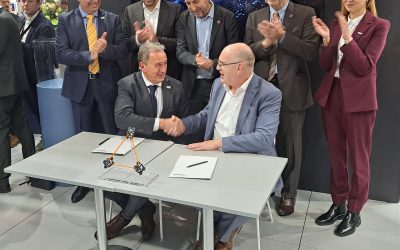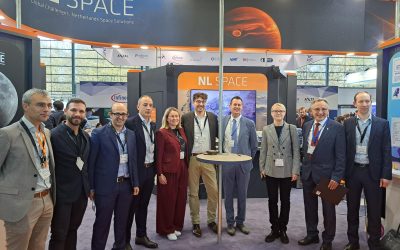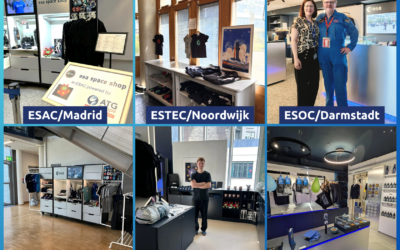EMPLOYEE SPOTLIGHT – Our own JUpiter ICy moons Explorers : Vicente AYCART & Maria Rossella CARANDENTE
This week we have had the chance to meet with not one but two of our colleagues –Vicente Aycart and Maria Rossella Carandente – Functional AIT Engineers at Airbus Defense & Space on behalf of ATG Europe. Both are working on the (JUpiter ICy moons Explorer). An ambitious project in collaboration with the European Space Agency.
In summer 2022, JUICE will begin a decade long cruise to Jupiter to spend three and a half years in the Jovian system. Its main mission will be to explore the huge planet’s three largest icy moons in the hope of determining whether life is possible on these dwarf planets. What if extra-terrestrial life does exist? For centuries, this question – which both fascinates and frightens humankind – has remained unanswered.
Could you tell us more about you and how you came to work for ATG?
Maria Rossella: Let’s say that I started thinking about space when I was in high School. During my final year I was studying astronomical geography when a small note at the bottom of the page caught my attention. It was explaining how satellite-based navigation system works, something that we use regularly in our daily file. I was fascinated by this world, and I decided to investigate this intricate industry. As you may know I come from Naples in Italy, and we have great Aerospace engineering courses there; I decided to take my chances and see where it would lead me.
During my Master I specialised more in Space System Engineering. Then I went to Barcelona for a semester as I was looking for an experience abroad. I loved it; Barcelona is an amazing city! And its university UPC gave me the opportunity to learn more about sailplanes – at the end of the course we had the chance to pilot one of those engineless planes; the experience of floating in the air and feeling the calmness of the nature was amazing.
Then it led me to Lisbon, where I obtained an internship in Orbital Mechanics at the Institute Tecnico Superior – the university where I simulated hyperbolic trajectories for a hypothetic Mars mission. During my Master Thesis I snatched an Airbus Defense & Space internship as part of the R&D department which convinced me that I wanted to focus more on what I loved during my studies in Naples: Attitude and Orbital Control Systems (AOCS). That is why I focused completely my Master Thesis on the development and simulation of AOCS for a new generation of CubeSat (FLP2), carried out in Airbus DS. After my Master Thesis, I decided to apply to all the space companies I knew, as it was time for me to find a first solid experience. That’s when I met Frank Jorritsma in 2019 and finally got the contract to work on JUICE. As you may have noticed, I was already familiar with Airbus “hiring” procedures, that made it a LOT easier! *Sighs – Now, I work in a team of 8 Functional AIT Engineers. I take care of testing some of the scientific instruments over a total of 10.
Vicente: I am from Spain. During my second year of Bachelor, I got a special internship to Florida. I started working on Mechanical Engineering, but my home city was not the best place to start a career in the space industry. My trip to the US enabled me to change Majors and pursue my dream. I lived 1 hour away from Cape Canaveral witnessing launches every month. It was a true motivational factor. I stayed there for almost three years and graduated. By that time, I knew I wanted to join TU Delft Spaceflight Master’s program to pursue my dreams for space.
After a 6 months gap before starting my master’s degree, I got the chance to get a 6-month job designing and calculating a fixed-wing RPA (Remotely Piloted Aircraft). I participated in the mechanical development of their fuselage with the labs. It’s funny to mention this, as I got to see it fly at the end of my period there, what a moment.
Then I moved to Delft and stayed there for most of my Masters. I specialised in Aerospace Engineering and Space Flight – my favorite domains. Of course, there was another mandatory internship to complete my course. So, in May 2018, this led me to Brussels in a company called Spacebel, developing software for Space applications and testing them.
In December 2018, I started a Master Thesis with Airbus Space & Defense on the topic of developing an algorithm for tracking the trajectory of launching vehicles from earth. A confidential topic, but a very interesting one which could help us prevent devastating strikes. A bit like the iron dome in Israel! I actually completed it in January 2020 while I was already working on JUICE. A daunting but rewarding task.
Long story short, I was then contacted by ATG Europe on LinkedIn for a specific position at Airbus Space & Defense. At first it didn’t work out but it didn’t matter, I had to finish my thesis. Later, a Functional AIT position opened, and since I was already doing my Master thesis at Airbus this made easier to obtain a job interview and get the job position. Quite impressive because my situation changed from one moment to the next. Usually, these changes take time!
Tell us more about JUICE (JUpiter ICy moons Explorer) and the mission?
Maria Rossella: It’s a very exciting and demanding project with intensive weeks of testing with all the companies that are participating in the manufacturing process. We have over 10 scientific instruments aboard all destined to check the very peculiar atmospheres JUICE will encounter.
Our job as Functional AIT Engineers is to make sure that the units are behaving nominally, i.e., commanding the unit to be in a specific operational mode and checking that the corresponding telemetry is as expected.
I have in mind a thrilling moment when I was testing one of the JUICE main payloads: JANUS, a high-resolution camera made of an Optical Head Unit (Telescope module) and a Cover Mechanism Module.
The test consisted of simply commanding the opening and closure of the cover. A normal reaction would be: “That´s it?” Well in principle the test is simple, but from my perspective, having the “power” of developing and executing the code that performs this test and actually being able to see the cover opening and closing is something that goes beyond the normal “That´s it”.
Our motivation is to have the Spacecraft there, in front of us, while testing it. This massive set of units with different individual features, which once assembled are perfectly matching towards the same scope: exploring the habitability potentials of Jupiter´s Moons Ganymede, Callisto and Europa.
Vicente: Maria Rossella and I have remarkably similar jobs. We’re part of the same team taking care of scientific payloads. I take care of testing such instruments. We make sure they are all functioning and tested for their future long spaceflight to Jupiter. Fro example we do deployment tests with an antenna, the point of this is to make sure that everything will be deploying correctly once in Space at ambient and in a vacuum environment.
Some of those instruments that we are integrating into the JUICE spacecraft are: MAJIS, a visible and infrared spectrometer which will be used for checking the light spectrum and the gas traces from Jupiter’s moons at destination. HAA: An accelerometer which is part of a bigger instrument called 3GM that will serve to measure very accurately the position of JUICE and determine the gravitational pull of Jupiter’s moons. 3GM is composed of KaT, a transponder for communications and USO, an ultra-stable oscillator. This combination of instruments allows us to make very precise orbital determinations, especially regarding JUICE’s internal components. On an extra note, we have a very interesting one called RIME – a radar that is being constructed by many third parties across the world such as JPL, Thales Alenia in Italy, and us, in charge of integrating all the parts together; a great international effort. Let us not forget that all these instruments could hint at life beyond our planet, a fascinating discovery.
In terms of classification JUICE is the biggest ongoing space exploration project in Europe, and I am we’re so proud to be part of it.
Why is it so important to head out and explore Jupiter’s icy moons: Europa, Callisto and Ganymede?
Maria Rossella: Well, its Space Exploration! We don’t know whats there and we want to know. The atmosphere, their surfaces and get to know these astral places better. Of course, we could spend our money better but if we don”t undertake such a trip, we’ll always be stuck on our own little bubble, we need to burst it. It’s a quest for answers on how we have come to exist.
Vicente: We hope to confirm the presence of liquid oceans mostly under the surface of Europa, Ganymede and Callisto. Can you imagine that! Keep in mind and that they are Moons with an icy crust. This discovery and hypothesis were supported by the Galileo spacecraft that visited Jupiter in the late 90’s. Imagine using the latter radar and confirm that there is an actual liquid ocean under the ice. We will check the composition and study it very closely if that is ever true. This mission carries a lot of hope and ambition.
Any challenges or successes you wish to acknowledge; has COVID impacted the project?
Maria Rossella: COVID was a major challenge as it pushed us to our limits. Impact the project but the managers have been outstanding. We worked from home, but testing happens on site. Therefore, management arranged special schedules to save as much time as possible for the remaining shifts. By the end of the year, we reached several milestones, that’s how ESA projects work in terms of approval processes. We’re witnessing this speeding up in processes, and our satisfaction is so great. We’ve worked so much but we’re so proud that we don’t even feel tired.
One moment I must acknowledge August 2019 to December. We had a rush moment where we had to test all the instruments on the JUICE Engineering Model which is based in Airbus DS Toulouse. We were spending one week in Toulouse and then back in order to prepare the new set. It was a very challenging but rewarding time as we succeeded and allowed JUICE to move to the next stage, a crucial step. We felt liberated!
Vicente: I have so many lessons! One of them would be focusing on the human aspect of the job. We work under a lot of pressure in an international environment. I can get these unexpected calls or night shifts all the time, because we have the common goal with the team to be one fo the only ESA projects to launch on time, and that requires a lot of constant work. It’s a little bit like our little Apollo Program here in Europe *laughs
More seriously I feel so blessed to work in such a team with such an international scope. Of course, it’s stressful but like Maria Rossella mentioned, you must keep the focus and learn to handle stress. We are also lucky enough to work on a fascinating project, so when times get hard, just remember the end goal which is beautiful.
Launch date announced?
Maria Rossella: As of today, not all the flight model instruments have been tested, but we’re all motivated to launch next year. We have an uncertain window aiming for summer 2022. The next steps take place in Noordwijk for the TBT (Thermal balance Thermal vacuum tests) at ESTEC. This will last until its shipping to Toulouse where we’ll continue some of the units’ tests and a vibration test. Finally, a second Thermal Vacuum test to get it all ready for its 10 years journey to Jupiter’s moons!
Vicente: I will align my answer with Maria Rossella’s, we are no trying to launch something that can be launched anytime. We have a planetary alignment to ensure in order to save fuel and reach Jupiter as fast as possible, that’s already 9 years, arrival expected in 2031. A delay today would equal to a delay of approximately 3 years. Also, keep in mind that our journey is not straight. Our way to Jupiter is to all about gaining acceleration with gravitational assists manoeuvres meeting Venus, Mars, and Earth again before shooting itself to Jupiter. What a feat!
What is the best career lesson you have learned on the project so far?
Maria Rossella: Before working here I was a very anxious person. Errors are also very scary moments full of red lights and warning signs. During my first test that I performed, I was faced with such an alert. I had to learn how to calm down and become a problem solver in stressful situations. I am now calmer than before; everything is easy after working on JUICE! *laughs
Vicente: My main objective is to learn something everyday. That is usually what happens when you work on projects like JUICE. I consider myself as inexperienced, but in 10 years I will be more efficient. I’m full of willingness and I can provide loads of it, and i’ll keep on thriving on it. We have a very very good engineering team at Airbus, so I learn from them on a daily basis. We keep picking each others brains on different experiences, we compare, apply and we make the project go even further.
What does innovation mean to you?
Maria Rossella: Personally, it’s exploring the unknown, arming us with the latest tech and innovation. In this case, space exploration is a perfect example of what innovation is. The space industry is changing to fast and we’ll soon be gathering the fruits of this acceleration.
Vicente: Nowadays we have the chance to be connected with everyone in the world. Especially after covid, we have people working from home office and making these feats happen. To me innovation is the action of doing what we have been doing, but in a more relaxed way, allowing us to spend more time with our relatives. We can become better with the help of everyone in the world. Connecting people is our greatest strength and we should bet on that.
What’s a fun fact about you many people may not know?
Maria Rossella: Well, as an Italian I like my food well cooked. I never eat at work even though we have a great canteen. It has to be on point, and I often get blamed for not eating with the colleagues, but we also find time for a coffee, another of my “passions” !
Another fact that people might not guess at first glance is that I used to play volleyball when I was in high school until the beginning of the university. As a matter of fact, I am not tall, but being able to play volleyball does not mean that. It means having the teamwork spirit, each one fighting for the same goal!
Vicente: I heard that from many people but, I used to do a lot fo rowing. Back when I got my internship to the US, I got it thanks to rowing. I have been a Spanish Campion in rowing, I had the chance to be in the Spanish national team and got second at the European championships with them. I went to Virginia, Tennessee and Philadelphia rowing and I love it. I’m actually looking forward toJUICE’s next testing phases taking place in Toulouse, I heard they have an excellent rowing team and I hope to join them. For now i’m on a bit of a break as work takes over but I always find the time for a little rowing.
What would you do (for a career) if you weren’t doing this?
Maria Rossella: Well, it would be In Space. I was thinking to apply to be an astronaut, Samantha Cristoforetti and her book really inspired me in the past. I don’t know if I would manage, I would love to try. Otherwise, I would probably just open a book shop, I read a lot and I love the smell of a brand-new book, a new story to uncover.
Vicente: Something completely different?! I have no experience in photography, but I think I would be an explorer working for National Geographic, exploring places, to Africa the Amazon jungle etc. *laughs
Well, you’re both not too far off today, a different kind of explorers! Thank you both for taking the time to enlighten us on such a stellar topic and how JUICE will answer some of our solar’s system hottest questions.
Best of luck for what’s to come!
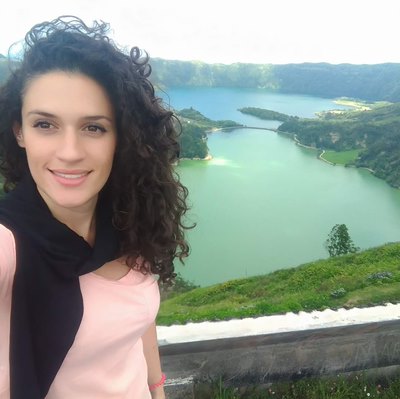
Maria Rossella CARANDENTE
Maria Rossella CARANDENTE - Functional AIT Engineer at Airbus Defense & Space on behalf of ATG Europe
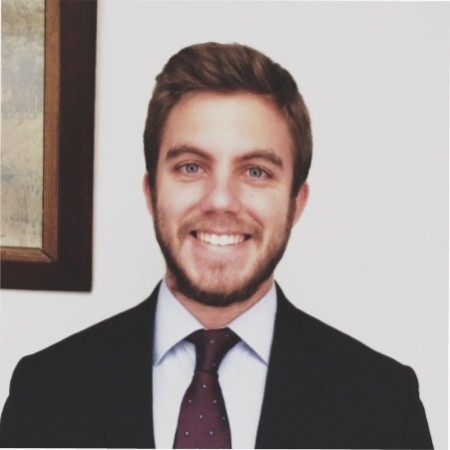
Vicente Aycart
Vicente AYCART - Functional AIT Engineer at Airbus Defense & Space on behalf of ATG Europe
